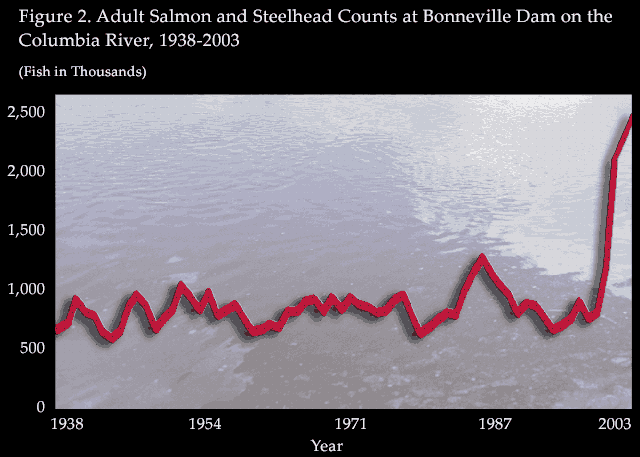
A decline in courage may be the most striking feature which an outside observer notices in the West in our days. . . . Such a decline in courage is particularly noticeable among the ruling groups and the intellectual elite, causing an impression of loss of courage by the entire society. Of course there are many courageous individuals but they have no determining influence on public life. . . . Should one point out that from ancient times decline in courage has been considered the beginning of the end?
Throughout the Northwest, hapless citizens labor to support the most expensive environmental boondoggle in the world, application of the Endangered Species Act to the dams and reservoirs throughout the Columbia Basin that collectively constitute the Federal Columbia River Power System (FCRPS). At the behest of environmentalist litigants, the Region's self-appointed salmon czar, Judge James A. Redden of the United States District Court in Portland has done his best to encourage the federal government to spend more and more money, setting aside the 2000 biological opinion governing dam and reservoir operations as inadequate. Judge Redden even struck down a rare Bush Administration initiative to reduce the fish taxes by roughly $60 million by reducing summer spill, notwithstanding proof that only a handful of endangered fish might benefit, including some of the same fish subject to a federally-approved harvest rate of over 30% .
One reason that Judge Redden made the decisions he did is that no one before him put up an effective fight against the environmentalists. Since the Region's state governments are for all practical purposes allied with the environmentalists, the only hope for getting the truth to Judge Redden came from entities such as Northwest Irrigation Utilities, the Public Power Council, Franklin County Farm Bureau Federation, Grant County Farm Bureau Federation, Washington Farm Bureau Federation, Pacific Northwest Generating Cooperative, the Ports of Lewiston, Whitman County, and Morrow, and even Shaver Transportation Company, all of which had intervened in the case before him. But they filed no claims of their own, instead echoing the government's positions, allowing environmentalists to litigate whether salmon recovery efforts were funded with sufficient certainty, rather than whether the Endangered Species Act actually required the salmon spending in the first place.
On November 30, 2004, NOAA Fisheries released a new biological opinion proposing to continue the spending boondoggle at a record clip, and beating a hasty retreat from any attempt to stop the waste. The new opinion continues the great hoax that dam operations jeopardize the continued existence of salmon, taking the position that jeopardy is only avoided by additional salmon spending, called "non-hydro offsets for habitat, hatcheries and harvest". The Bush Administration's decision ignores remarkable upsurges in salmon runs that demonstrate that dam operations are not jeopardizing the continued existence of salmon:

Judge Redden promptly set a deadline of December 30, 2004 for any party wishing to file claims against this new biological opinion. On that day, the environmentalists filed a fifty-two page complaint, but none of the other parties met the deadline. Once again, the stage is set for the environmentalists to complain the government is not doing enough, and for the government and others to say that everything is just fine.
But everything is not fine. The new biological opinion is a pack of lies that falsely blames the dams for every imaginable source of mortality, presumably in order to justify the ever-growing "mitigation" expenditures. NOAA gets both the law and the facts wrong, and after this many years, their errors can no longer be ascribed to mere incompetence.
As to the law, the purpose of a biological opinion is to assess whether dam operations jeopardize the continued existence of listed fish. NOAA does make an initial, twisted attempt to assess the effects of dam operations, using a bogus computer model and such input parameters as overstated turbine mortality estimates from the 1950s. But then NOAA tacks on "cumulative impacts", which it defines, roughly speaking, to be anything bad that is likely to happen to salmon anywhere in the Northwest, under the assumption that everyone other than dam operators will be allowed to kill salmon hand over fist for the indefinite future.
As to the facts, NOAA casts aside decades of research to conclude that smolt transportation kills fish and finds, contrary to the opinions of its own scientists, that there is a powerful relationship between tiny incremental changes in river flow and salmon survival. In the biological opinion, NOAA goes so far as to model the effect of drying up the Columbia Basin Project, and dumping the "conserved" water in the River, claiming (falsely) that big increases in survival would result. Every section of the biological opinion is littered with junk science, eloquent testimony to the uselessness (or malignancy) of Bush's political appointees.
While the Region sleeps, the environmentalists do not. Their new complaint and notice of intent make it clear that they seek not only to set aside the new biological opinion as inadequate, but also to enjoin such things as "producing power with water otherwise necessary to save fish" and "delivering water for irrigation". A December 6, 2004 editorial in the New York Times confirms that dam removal remains the long term goal of the enemies within. If the Region cannot rouse itself to do more than tell Judge Redden to trust the government, instead of telling him the truth, we can all expect, at best, even higher fish costs in the future.
© James Buchal, January 3, 2005
You have permission to reprint this article, and are encouraged to do so. The sooner people figure out what's going on, the quicker we'll have more fish in the rivers.
![]()
Return to Other Salmon Materials
Return to www.buchal.com